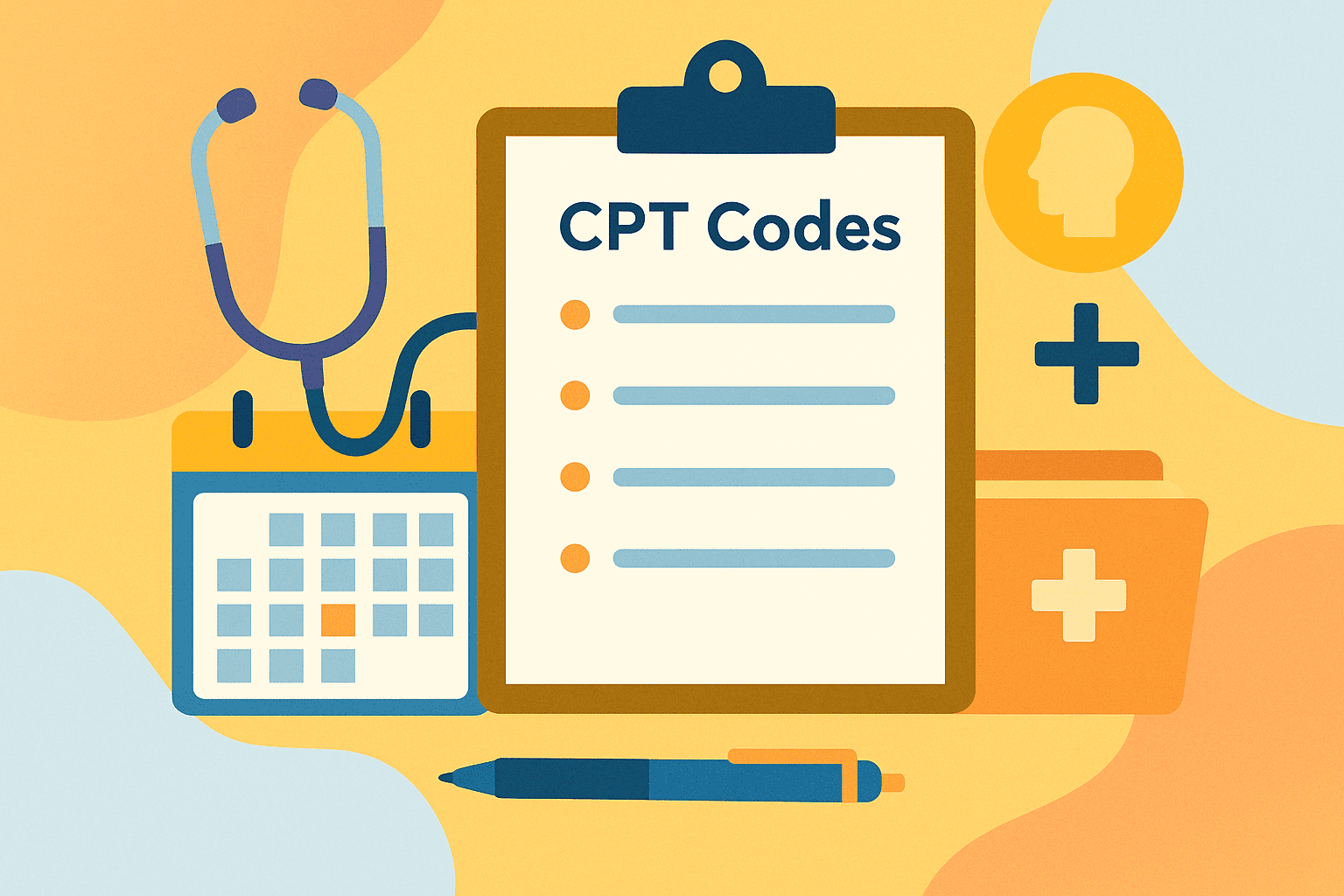Updated on: July 28, 2025
Introduction
Accurately coding your services with the right CPT® codes is essential for reimbursement, compliance, and efficient practice management. This guide explores the most commonly billed CPT codes in behavioral health—including intake evaluations, individual therapy, family and group counseling—and examines trends in usage, reimbursement, and documentation best practices.
What Are CPT Codes and Why They Matter
CPT (Current Procedural Terminology) is maintained by the American Medical Association and defines five-digit codes used for billing medical and behavioral health services.
In mental health, CPT codes cover diagnostic evaluations (90791/90792), individual psychotherapy (90832, 90834, 90837), group, family, crisis, and add-on codes.
Correct coding enables accurate billing, establishes medical necessity, and reduces the risk of claim denials or audits.
Most Frequently Billed CPT Codes in Mental Health
According to national analyses and provider surveys:
- 90837 (Psychotherapy, 60 minutes) consistently ranks as the most billed CPT code across U.S. clinicians.
- Other top codes include: 90834 (45-minute psychotherapy), 90791 (initial diagnostic evaluation), and 90847 (family therapy with patient present).
List of top CPT codes often billed:
- 90837 – 60-minute psychotherapy
- 90834 – 45-minute psychotherapy
- 90832 – 30-minute psychotherapy
- 90791 – Psychiatric diagnostic evaluation (initial intake)
- 90847 – Family psychotherapy (with patient present)
- 90846 – Family therapy without the patient
- 90853 – Group psychotherapy
- Telehealth modifiers of core codes (e.g. 90834-95, 90837-95) for virtual delivery
How Usage Is Calculated
One study analyzed over 2.2 million appointments billed with codes 90837, 90834, and 90791, revealing that reimbursement patterns vary by code and region.
National billing data shows 90837 dominates due to clinician preference and payer allowance for 60-minute sessions when medically appropriate.
CPT Time Rule & Documentation Requirements
CPT rules are time-based:
- 90832: 16–37 minutes
- 90834: 38–52 minutes
- 90837: 53+ minutes
Use the code matching the closest session duration, rounding down or up per the CPT “time rule.” Providers must document exact start and stop times to support coding, especially for longer sessions (90837).
Add-on codes: Examples include interactive complexity or crisis add-ons; used when a service requires more effort beyond typical therapy time.
Reimbursement Patterns and Financial Analysis
Median insurance reimbursement per CPT code (based on national patterns):
- 90837 receives the highest average reimbursement, followed by 90834, then 90791.
- However, reimbursements widely vary by state, payer, and provider licensure.
Practical takeaways:
- Code selection impacts average earnings per session.
- Understanding reimbursement tiers helps providers set self-pay rates or negotiate paneled reimbursement.
Example Chart: Reimbursement by Code (Sample Data)
| CPT Code | Service | Typical Insurance Payment | Self‑Pay Suggested |
|---|---|---|---|
| 90837 | 60 min Psychotherapy | $110–130 | $150–200+ |
| 90834 | 45 min Psychotherapy | $80–100 | $120–160 |
| 90791 | Initial Evaluation | $150–170 | $200–250+ |
| 90847 | Family Therapy (50m) | $90–110 | $130–170 |
| 90853 | Group Psychotherapy | $35–50 per person | $60–80 per person |
Telehealth Trends and New Code Usage for 2025
In 2025, continued expansion of telehealth codes has allowed synchronous audio-video sessions to be billed using modifier 95, while audio-only services may use alternative designated codes.
Providers must confirm payer policies regarding telehealth reimbursement, allowable codes, and modifiers. Proper setup in practice management systems is critical for claim integrity.
Best Practices: Billing Compliance & Quality Assurance
- Document time precisely: Especially with 90837, insurers may audit records to confirm sessions lasted 53+ minutes.
- Use correct modifiers: Telehealth (‑95), interactive complexity add-ons, or crisis service codes as needed.
- Match diagnosis to procedure: CPT claims must align with ICD diagnoses to meet medical necessity criteria and prevent denials.
- Stay current: CPT code updates occur annually (e.g. 2025 saw hundreds of new, deleted, or revised codes).
Pain Points & Risk Mitigation
Common billing challenges:
- Overuse of 90837 without documentation leads to reimbursements clawback.
- Mis-timed session coding.
- Failure to confirm payer telehealth allowance.
- Using incorrect diagnosis or mismatched codes causing denial or audit risk.
Mitigation Strategies:
- Track time in session via secure, timestamped EHR notes.
- Audit your billing monthly: review top-billed codes, denial reasons, and coding patterns.
- Train or collaborate with certified coders or billing services.
- Use superbills and clear client communication.
Strategic Recommendations for Therapists and Practices
- Review your billing analytics, focusing on frequency and reimbursement by CPT code.
- Adjust self-pay pricing to align with payer reimbursement benchmarks per code.
- Ensure documentation rigor for longer sessions and higher-value codes.
- Keep abreast of CPT updates—especially for telehealth and add-on codes in newly effective payer policies.
- Make use of add-on codes when applicable: interactive complexity, crisis service, family involvement modifiers.
- Invest in coder training or support, especially if you see high volume or diverse services.
Case Scenarios
Solo clinician focusing on trauma and short‑term work:
Likely bills mostly 90834 sessions. Ensure documentation is robust and avoid unnecessary upcoding.
Established practice offering longer intake plus extended therapy:
Code mix may include multiple 90791 evaluations monthly and a majority of 90837 sessions. Audit time documentation carefully.
Summary & Outcome
- CPT code 90837 remains the most commonly billed and highest-reimbursing psychotherapy code.
- 90834 and 90791 follow closely as essential codes for therapy and intake.
- Accurate coding, maintained documentation, and staying current with updates are imperative for practice success.
- Understanding reimbursement ranges helps inform both self-pay rate-setting and network contracting.
Confused about which CPT codes to prioritize in your practice?
Join DocScrib to simplify documentation and billing—let our AI-driven platform auto‑suggest appropriate CPT codes, support compliance, and streamline your revenue workflow. Book your free demo
